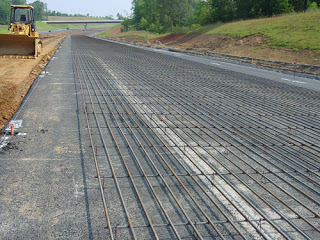Cement Concrete both Plain and Reinforced overlays are used as a rehabilitation technique for both existing Rigid and asphaltic pavements. Concrete overlays have potential advantage over asphaltic overlays owing to :-
- Extended service life
- Increased structural capacity
- Reduced maintenance requirements
- Lower life-cycle costs
When compared with hot-mix asphalt overlay alternatives
Concrete overlays have been used to rehabilitate existing concrete pavements since 1913 and to rehabilitate existing asphalt pavements since 1918.
Type of Concrete Overlays
The Concrete pavements as we know are of following three basic types :-
1. Jointed Plain Concrete Pavements
2. Jointed Reinforced Concrete Pavements
3. Continuously Reinforced Concrete Pavements
Although in theory any type of concrete pavement could be used for an overlay, in practice, jointed plain concrete pavement (with or without dowels) is by far the most common.
Jointed Plain Concrete Pavement
JPCP is a Plain cement concrete pavement system that have joints at shorter distances and does not have distributed reinforcing steel in the slab and may or may not have dowels. Maximum slab length is typically 20 ft (6 m). Undoweled or aggregate interlock joints are generally used for short slabs, thin slabs, or both.
For most pavements, however, adequately sized dowels should be provided to reduce faulting. Dowel diameter is often selected based on slab thickness, but traffic may be a more important factor for consideration.
For concrete overlays, the recommended number and spacing of dowels is the same as those for new pavements. In general uniform 12 in. 300 mm spacing is recommended but non-uniform dowel spacing design, the dowels are concentrated in the wheel paths
In general, joints perpendicular to the direction of traffic are recommended. On new JPCP, skewed joints can be effective in reducing faulting on nondoweled pavements, but have no effect when used on properly doweled pavements. Futhermore, JPCP designs with skewed joints constructed on a stiff base (treated cement or lean concrete) are prone to corner breaks.
|
|
Bonded
|
Partially bonded
|
Unbonded
|
|
Typical thickness
|
3 to 4 in. (75 to 100 mm)
|
6 to 8 in. (150 to 200 mm)
|
6 to 12 in. (150 to 300 mm)
|
|
How bonding condition is achieved
|
Cleaning and preparing surface
(such as shotblasting)
Possible application of bonding
agent
|
No special surface preparation
other than sweeping
|
Placement of a layer to separate
overlay from existing pavement
|
|
Condition of existing pavement
|
Relatively good condition
No materials-related distress
|
Fair to moderate condition
|
Fair to poor condition
|
|
Preoverlay repair
|
All deteriorated cracks, joints, and
punchouts
|
Most deteriorated cracks, joints,
and punchouts
|
Limited repair
|
|
Special design and construction
considerations
|
Achieving bond between two concrete
layers
Matching joints of overlay with
those in existing pavement
|
Matching joints of overlay with
those in existing pavement
|
Achieving separation between two
concrete layers
Mismatching joints of overlay with
those in existing pavement
|
|
Overlay types
|
JPCP
JRCP
CRCP
|
JPCP
JRCP
CRCP
|
JPCP
JRCP
CRCP
|
Jointed Reinforced Concrete Pavements
JRCP is a hydraulic cement concrete pavement system containing dowels, characterized by long joint spacings and distributed reinforcing steel in the slab to control crack widths. Slab lengths are generally more than 20 ft (6m) and may be as much as 60 ft (18 m). Current pavement practice is away from JRCP designs, and construction is rare because the longer joint spacing results in more joint movement. When midslab cracks occur, the light reinforcing may not be enough to hold the cracks tightly. If JRCP is used, the recommended maximum joint spacing is 30 ft (9m). Deformed bars or deformed welded wire reinforcement are recommended at minimum steel content of 0.19 %.
Continuously Reinforced Concrete Pavements
CRCP, also known as continuous concrete pavement, is a pavement with uninterrupted longitudinal steel reinforcement and no intermediate transverse expansion or contraction joints. Reinforcement design for CRCP overlays is similar to that for new design. The recommended minimum steel content is 0.60%, and the use of deformed bars is strongly recommended (Darter et al. 1997). The depth of reinforcing steel has a significant effect on crack opening, and steel placement closer to the top surface may provide tighter cracks and better long-term performance (Dhamrait and Taylor 1979; Roman and Darter 1988). A minimum concrete cover of 2.5 in. (65 mm) is recommended for protection of the reinforcing steel against corrosion.
















